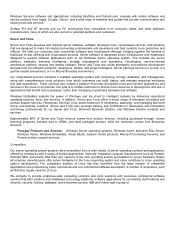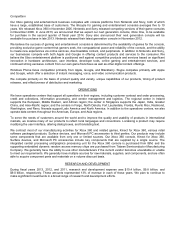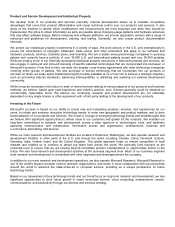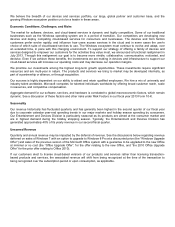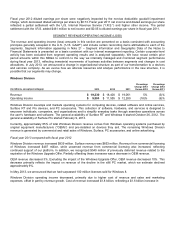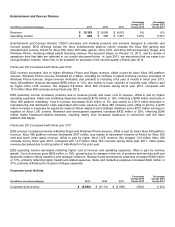Microsoft 2013 Annual Report Download - page 19
Download and view the complete annual report
Please find page 19 of the 2013 Microsoft annual report below. You can navigate through the pages in the report by either clicking on the pages listed below, or by using the keyword search tool below to find specific information within the annual report.We believe the breadth of our devices and services portfolio, our large, global partner and customer base, and the
growing Windows ecosystem position us to be a leader in these areas.
Economic Conditions, Challenges, and Risks
The market for software, devices, and cloud-based services is dynamic and highly competitive. Some of our traditional
businesses such as the Windows operating system are in a period of transition. Our competitors are developing new
devices and deploy competing cloud-based services for consumers and businesses. The devices and form factors
customers prefer evolve rapidly, and influence how users access services in the cloud and in some cases the user’s
choice of which suite of cloud-based services to use. The Windows ecosystem must continue to evolve and adapt, over
an extended time, in pace with this changing environment. To support our strategy of offering a family of devices and
services designed to empower our customers for the activities they value most, we announced a functional realignment in
July 2013. Through this realignment our goal is to become more nimble, collaborative, communicative, motivated, and
decisive. Even if we achieve these benefits, the investments we are making in devices and infrastructure to support our
cloud-based services will increase our operating costs and may decrease our operation margins.
We prioritize our investments among the highest long-term growth opportunities. These investments require significant
resources and are multi-year in nature. The products and services we bring to market may be developed internally, as
part of a partnership or alliance, or through acquisition.
Our success is highly dependent on our ability to attract and retain qualified employees. We hire a mix of university and
industry talent worldwide. Microsoft competes for talented individuals worldwide by offering broad customer reach, scale
in resources, and competitive compensation.
Aggregate demand for our software, services, and hardware is correlated to global macroeconomic factors, which remain
dynamic. See a discussion of these factors and other risks under Risk Factors in our fiscal year 2013 Form 10-K.
Seasonality
Our revenue historically has fluctuated quarterly and has generally been highest in the second quarter of our fiscal year
due to corporate calendar year-end spending trends in our major markets and holiday season spending by consumers.
Our Entertainment and Devices Division is particularly seasonal as its products are aimed at the consumer market and
are in highest demand during the holiday shopping season. Typically, the Entertainment and Devices Division has
generated approximately 40% of its yearly revenue in our second fiscal quarter.
Unearned Revenue
Quarterly and annual revenue may be impacted by the deferral of revenue. See the discussions below regarding revenue
deferred on sales of Windows 7 with an option to upgrade to Windows 8 Pro at a discounted price (the “Windows Upgrade
Offer”) and sales of the previous version of the Microsoft Office system with a guarantee to be upgraded to the new Office
at minimal or no cost (the “Office Upgrade Offer”, for the offer relating to the new Office, and “the 2010 Office Upgrade
Offer” for the prior offer relating to Office 2010).
If our customers elect to license cloud-based versions of our products and services rather than licensing transaction-
based products and services, the associated revenue will shift from being recognized at the time of the transaction to
being recognized over the subscription period or upon consumption, as applicable.


